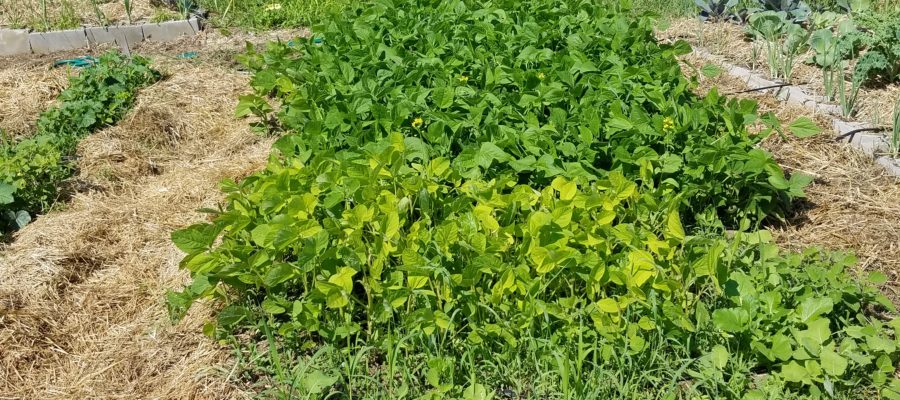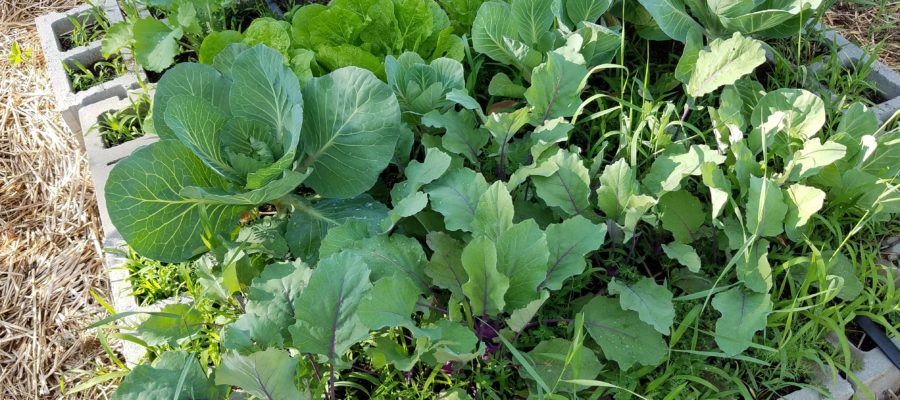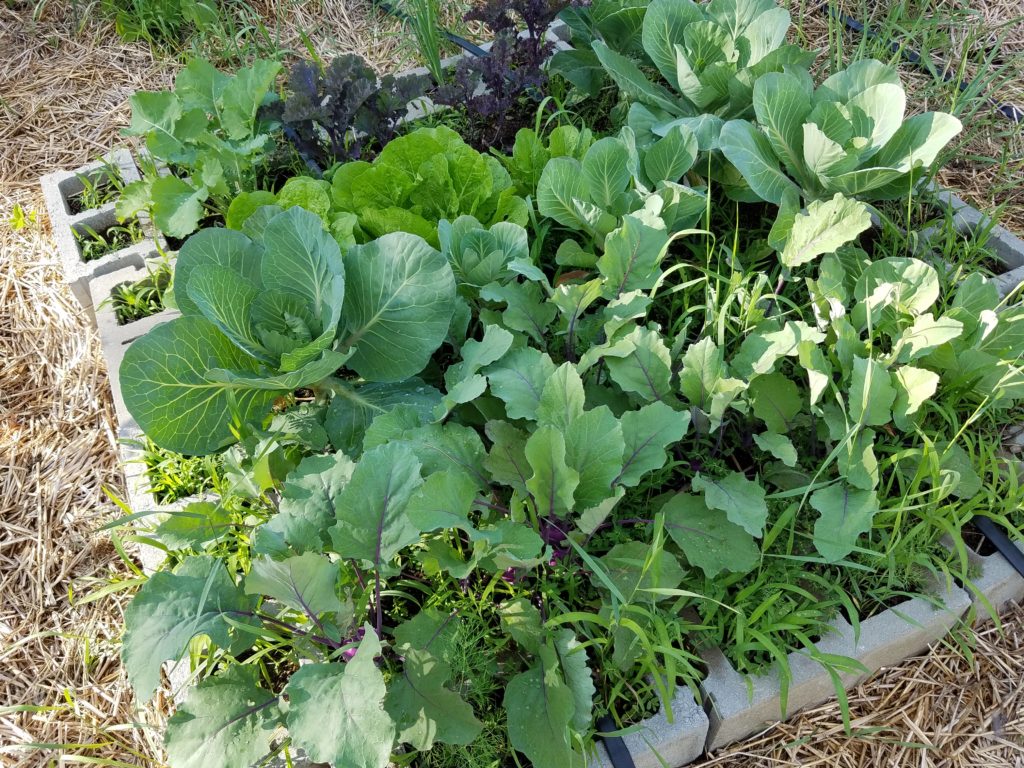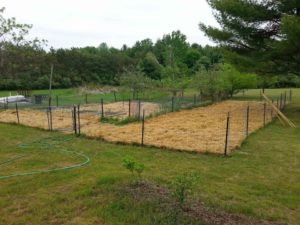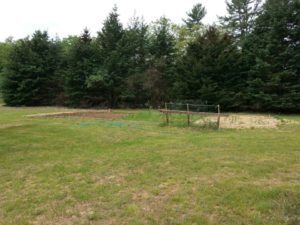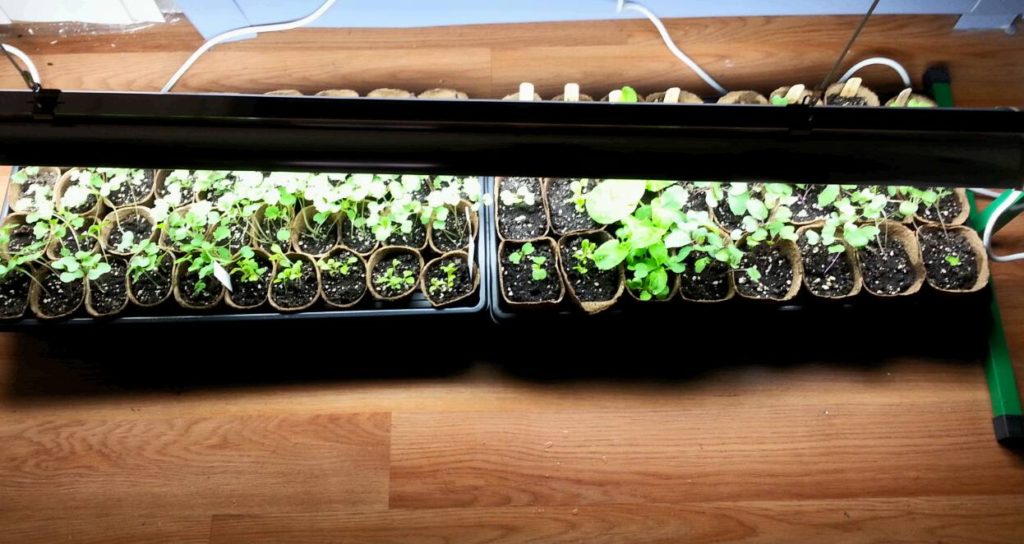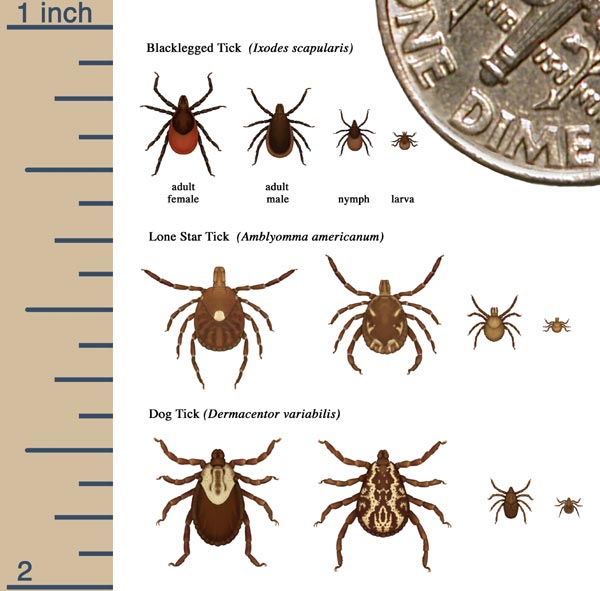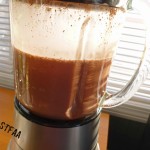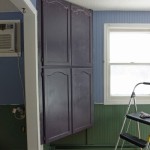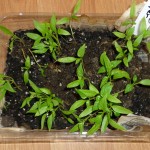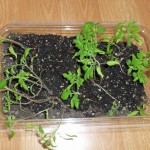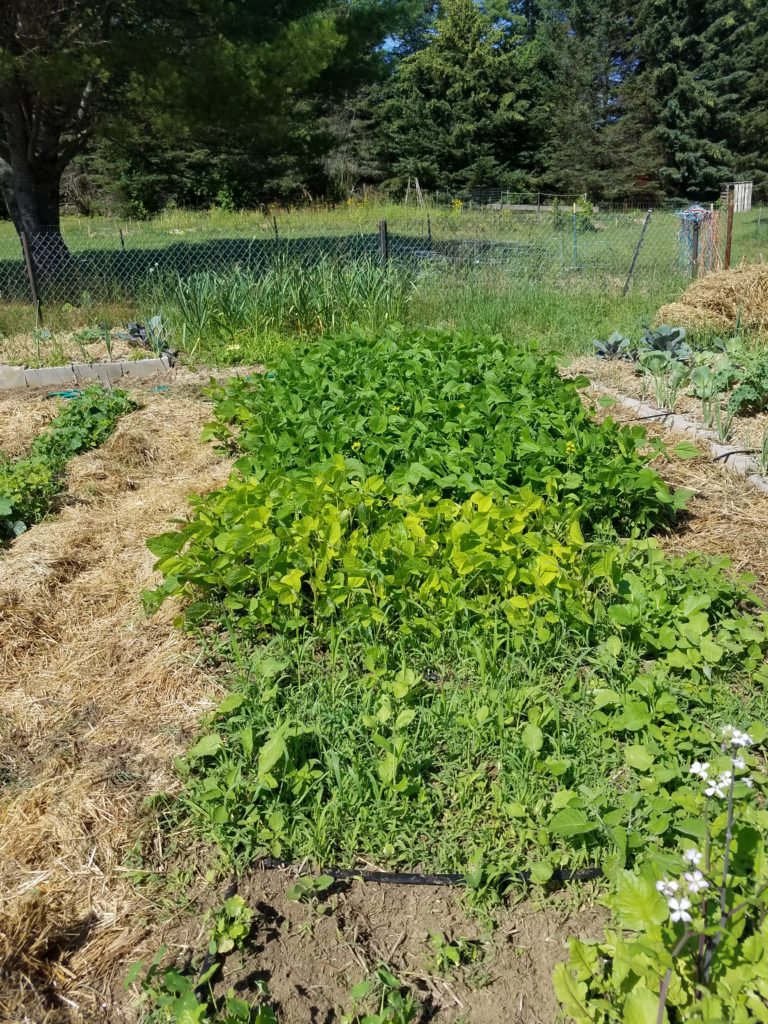
So since tax day is almost here, MaryKate and I were talking about money. Besides more expensive food, you end up buying a lot of kitchen equipment, and if you have a corn allergy, you might end up buying a lot of food preservation equipment, freezers, and in my case, a house so you can grow a lot of your own spray free food (see my post on buying the house – WW: Living with Food Allergies – Making Unexpected and/or Unwanted Lifestyle Changes and my post on gardening – WW: Gardening due to Food Allergies & Planning your Garden & Starting Seedlings). These expenses have been gradual and over a period of time, and this isn’t everything, since I’m leaving out a lot of the specialty food expenses and some kitchen stuff I already owned, but I thought that talking about it may help some people.
Kitchen tools:
Crock pots – I have one of almost every size, and two of the seven quart ones. I use them to cook meals, and I use them to cook down apple butter, pear butter, tomato paste, and tomato sauce, although I did buy a Oster 20 quart roaster to use this upcoming canning season to try to cut down on extension cords and the number of Crock pots running at the same time. All of my Crock pots are manual, as I find the digital ones cook too hot.
- 1.5 quart – $16
- 3 quart – $22
- 4.5 quart – $30
- Two 7 quart – $45 each
- 20 quart Oster roaster $40 (on sale)
Meat slicer – We actually got this as a wedding present because my husband wanted one because he used to work at a deli, and we already had a lot of stuff because we were older when we got married and we were already living together. I use it when I cure pork belly into bacon, and when I cure brisket into pastrami to slice things evenly. We didn’t use it much before food allergies but we use it quite a bit now.
- Chef’s Choice 6090000 Food Slicer (Aluminum version) $99
Stand Mixer and attachments – I’ve posted about my KitchenAid mixer in the past (WW Kitchen Stories: Denise’s KitchenAid Mixer) but it predates my food allergies. I use the Food Grinder attachment in conjunction with the KitchenAid Fruit and Vegetable Strainer attachment to make vats of home canned applesauce and tomato sauce. I also use it in baking muffins, cookies, cakes, and pie dough. I use it to make Aquafaba whipped cream, and I use it to make pasta. I really want the KitchenAid KSMPEXTA Gourmet Pasta Press Attachment with 6 Interchangeable Pasta Plates and I may buy the KitchenAid KSM2APC Spiralizer Plus Attachment with Peel, Core and Slice, Silver, to process my apples, so that I don’t have to use a hand crank apple peeler for my apple harvest (I have 18 trees), but I have not yet purchased them. I’m trying to be restrained here, even though I’m a kitchen gadget junkie.
- KitchenAid Mixer Kit 4.5-Quart Tilt-Head Stand Mixer – $200
- KitchenAid Food grinder attachment $40
- KitchenAid FVSP Fruit and Vegetable Strainer Parts for Food Grinder $23
High Performance Blender – I waited three years to buy my Vitamix blender because I’m wicked cheap and the price tag was killing me. I got the Vitamix 5200 Blender Super Package from Costco which has the dry container for grinding grains, beans, rice and soybeans into fresh flour and the regular wet blender container. It’s the the one thing that honestly I probably should have bought from day one. I use it to make cashew milk and rice milk without having to strain it. I use it to make salad dressings. I use it to grind my own chili powder, curry powder, garam masala and other spice blends from whole spices in large quantities, as well as grind whole spices into powder. (Powdered spices are often cross contaminated or have anti-caking agents which are a problem.) I use it to make my own flours from dry beans and rice. I use it to make fruity drinks from my safe vodka or rum, my homemade jams, and ice. I use it to puree the peppers I ferment to make hot sauces. I use this thing almost every day.
- Vitamix 5200 Blender Super Package $500
Spice Grinder – Sometimes you need to just grind a small amount of something for a recipe. When you only need to process a tablespoon of something, the Vitamix is the wrong tool because you need a larger amount for it to work well. I had a spice grinder before I had the Vitamix and I still use it after the Vitamix.
- Cuisinart SG-10 Electric Spice-and-Nut Grinder $36.00
Meat Grinder – I can hear you now. Why does Denise need a meat grinder if she has the grinder attachment for the KitchenAid? My answer is that the KitchenAid Food Grinder works great for once in a while grinding of meat in small amounts. However, I’m sort of beyond that level at this point. I need to grind tallow and leaf lard to render down my own tallow and lard for cooking and to make my own margarine. Fats are tough products to grind, and I needed more muscle since I cracked the plastic housing on the Food Grinder last time I ground tallow (still works for now, ugh), and my KitchenAid motor really struggles with grinding the tallow and leaf lard and overheats. With the meat grinder, I can grind 5 pounds of frozen leaf lard in about a quarter of the time that I took me with the KitchenAid.
- STX-4000-TB2 Turboforce II “Quad Air Cooled” White Electric Meat Grinder & Sausage Stuffer $240
Dehydrator – I bought a dehydrator during the year of the great pepper harvest. My friend Mary S. agreed to grow peppers for me before we had the house, and well, she harvested 11 pounds of various chilies. I couldn’t manage to can or ferment all that before it went to waste and we didn’t have freezer space at that time, so I ordered a dehydrator to preserve the harvest. Now I use the dehydrator to make fruit leather using left over apple pulp when I steam juice apples to get juice to make jelly or apple juice. I dry herbs, peppers, and kale from the garden to use during the winter. I also use it to dry peanuts and cashews after soaking them so that I can make my own nut butters. I use it to make raisins, dried apples, and other dried fruits. It’s getting quite a lot of use for a spur of the moment, desperation purchase.
- Nesco FD-1018A Gardenmaster Food Dehydrator, 1000-watt $140
- extra dehydrator trays $30
Food processor – I had a smaller food processor, but I sort of melted the container when I left it too close to a burner on the stove, so I now use it to shred soap to make my laundry detergent. I replaced it with a 14 cup model. I use it for slicing vegetables to make pickles and shredding vegetables to make pickles and relishes, and dicing vegetables to make salsas. This gets a workout during canning season. I also use it to make larger batches of nut butters.
- Cuisinart DFP-14BCNY 14-Cup Food Processor $150
Juicer – I use a cheapo juicer to juice apples to make hard cider. Remember that I have 18 apple trees and I need to get rid of a lot of apples. I really want a cider press, but that will run me about $500, so the small juicer is working fine for now, if time consuming. Please remember that almost every commercial juice will be corny in some way, so if you need fruit juices it’s best to juice your own.
- Hamilton Beach Juice Extractor, Big Mouth, Metallic $60
Pressure Cooker – I have big pressure canners that I can use to cook in, but they are way too large to deal with on a day to day basis. I use this to make yogurt from cashew milk, make rice, steam vegetables, and I make a lot of soups, stews, and other dishes in it quickly, without having to stir or babysit them. I like it better for weekday use than a slow cooker because I don’t have to plan ahead or leave things on a timer. We use it enough that I ordered an extra pot for it so that we can make things back to back without having to empty the pot and wash it right away.
- Instant Pot DUO60 6 Qt 7-in-1 Multi-Use Programmable Pressure Cooker, Slow Cooker, Rice Cooker, Steamer, Sauté, Yogurt Maker and Warmer $70 (on sale)
- Extra pot $30
Knife Sharpener – Sharp knives work better and you’re less likely to get hurt, allegedly. For a long time, I kept thinking I would take my knives in to be sharpened at a local kitchen place, but the reality is, I don’t feel like I can be without my knives that long, so I don’t. I cook every single day and I need the knives. I know that electric knife sharpeners are not as good as professional knife sharpening, but sometimes something is better than nothing.
- Presto Professional Electric Knife Sharpener $36
Cast iron wok – I use this primarily for deep frying. When MaryKate and I originally learned to deep fry, we used stainless steel pots, but the wok uses so much less oil and you have much less splatter everywhere. I have a big Lodge wok and a smaller Utopia Kitchen wok. I use the larger one when I am frying a lot of food in quantity to freeze for later, and the smaller when I just have a yen for a little something. I also use both for stir frying as well. You don’t need both, and neither do I, but I like the flexibility.
- Lodge Pro-Logic Cast Iron Wok, Black, 14-inch $45-50 (on sale)
- Utopia Kitchen Cast Iron Shallow Concave Wok, Black, 12 Inch $18.00
Digital Kitchen scale – If you’re doing any sort of gluten free baking, a digital kitchen scale is helpful. I also use it quite frequently in canning, as recipes will call for so many pounds of an ingredient. I prefer to have one that measures at least up to 10 pounds and reads in pounds, ounces and grams. Mine is a cheap one I ordered online.
- Etekcity 15lb/7kg Digital Kitchen Food Scale, 0.01oz Resolution $12
Digital Meat Thermometer – This made a real difference in our cooking. Since every meal is at home, we want our food to be done right. I can now cook a steak that compares with a restaurant cooked steak, and we don’t have overdone dry pork chops any more (unless someone isn’t paying attention).
- ThermoWorks ThermoPop Super-Fast Thermometer with Backlit Rotating Display (Purple) $30
Canning stuff:
After my corn allergy diagnosis, when I realized that I would literally have to make everything from scratch, and we were living in an apartment and did not have freezer space to freeze everything and we were having winter power outages that lasted 4-5 days every other winter, canning looked really attractive because it’s shelf stable. If you have a corn allergy and decide to can, be aware that some of us react to the Ball canning lids, and the Tattler canning lids. Don’t invest in a lot of stuff until you know whether you react or not. Luckily, I’m still doing okay.
Pressure Canners: Pressure canners allow you to can low acid food safely without getting botulism. If you take up canning, you need to do a lot of research and follow safe recipes in order to be safe. I originally ordered the smaller pressure canner, but realized that it was costing me a ton of time to do two batches, and I ended up ordering the larger one. I can do 10 pints in the smaller canner, but 19 in the larger canner. Now sometimes I run both of them at the same time, particularly when I’m canning quarts, as I can do 14 quarts at once between the two of them. I also use the larger canner as a cooker to make bone broth and vegetable stock in a very short period of time. You can buy cheaper pressure canners in the range of $80, but then you have to buy a new gasket every season which runs about $50. The All Americans have a metal to metal seal, and you just need to get a new rubber over-pressure safety plug every year which is about $7. The All Americans are very heavy cast aluminum and they will last forever. If I were to do it over, I’d have ordered the larger one first, and probably not have two.
- All-American 15-1/2-Quart Pressure Cooker/Canner $175 (on sale)
- All American 921 21-1/2-Quart Pressure Cooker/Canner $210 (on sale)
Water Bath Canning Pots – Water bath canning is for high acid foods like jams, jellies, pickles and salsa. I was using a Granite Ware 21.5-Quart canning pot, which are only about $20, but I literally wore two of them out because they are so flimsy. You can use any large stock pot (10 quarts or larger) to do water bath canning, but I like to do large batches so I have a 20 quart and a 32 quart pot.
- 20 quart stainless steel pot $61
- 32 quart stainless steel pot $91
Canning Element Kit for electric stoves – This replaces your electric burner element to have more heavy duty support (canning pots are freaking heavy) and a higher wattage burner. I’m on my third. Because of the volume I do, I keep wearing them out.
- Canning element kit $37
Extra burner – I often need an extra burner because if I have two pressure canners going, I wouldn’t have room to cook the thing I’m canning on the stove. This burner is high enough wattage to run a canner on it.
- Cadco PCR-1S Professional Cast Iron Range $130
Steamer Juicer – This is the easiest way to juice fruit to make jams and jellies and can fruit juice. It’s an expensive toy, but the time and hassle it saves makes it worth it for me.
- Cook N Home NC-00256 11-Quart Stainless-Steel Juicer Steamer $95
Canning tools – You’ll need some canning tools, a canning funnel, bubble remover, jar lifter, and so on.
- Presto 7 Function Canning Kit $15
- NORPRO 591 Bubble Popper/Measurer $5
Canning books – You’ll need some canning books to learn safe canning techniques and safe recipes. My canning book collection is about $200 at this point.
Canning Jars – Depending on the size, canning jars range from $8 to $12 a case retail. Because I can in high volume and I store spices, rice, beans, and flours in jars, I probably have close to 2,000 jars in the house, as there were nearly 1,500 in canned goods alone at the end of the canning season last year. I didn’t pay for them all, as I’ve been gifted jars when people stop canning and downsize, and I got quite a few cases on very deep discount during sales, but it’s an expense when you start.
Ball Canning Lids – Canning lids can only be used to can food once. I reuse lids for dry storage, but you can’t reuse them for canning. I generally spend about $50 to $100 a season on lids. The cheapest I can find them is sadly Walmart where I’m able to get a pack of 12 for between $1.79 to $1.97 depending on the sale. I generally buy a 24 pack case at a time if I get a good price.
Fermenting stuff:
I learned how to ferment because when I lost corn I wasn’t going to go without Sriracha and my other hot sauces. It just wasn’t going to happen. Once I got my feet wet with hot sauces, I started making sauerkraut and kimchee, and then progressed to hard cider, my own really bad wine, and my own apple cider and wine vinegar.
I primarily ferment in quart mason jars and half gallon jars depending on the volume of what I’m making. You can buy fermenting caps for jars online. When I first started, I bought some premade stuff, and then later I made my own as it was cheaper, when I needed to have more caps available as I fermented more stuff. I also found having a tamper for packing vegetables in jars to be helpful. When I make cider, I ferment in a three gallon carboy and a 1 gallon carboy I got from a wine kit, and when the cider is done fermenting I store in it in 32 ounce swing top bottles.
- STARTER KIT 6 Mason Jar Fermentation Lids with Food Grade Grommets, Airtight Seals, and Stoppers AND 2 3-Piece Airlocks (REGULAR MOUTH) $30
- Kraut Kaps 3 Pack – Platinum $30
- Small Wooden Cabbage Tamper for sauerkraut $10
- airlocks $6
- 3 Piece Econo-Lock with Carboy Bung (Set of 2) $6
- 1 Gallon Wine from Fruit Kit $40
- 3 Gallon Glass Carboy $30
- Cobalt Blue 32 oz. EZ Cap Beer Bottles, CASE OF 12 $43
Stuff to make cleaning and personal care products:
So when you’re allergic to corn and coconut, and their derivatives are in everything, you make your own everything (bar soap, liquid soap, dishwasher detergent, lotions, makeup, etc.) I’m not going to list every ingredient I use to make stuff (a lot of this stuff is on the blog if you search), but suffice it to say, there’s an awful lot of essential oils, various oils, beeswax, shea butter, borax, washing soda, and so on in this house. Frankly, I’m feeling like this post is going on forever, and I’m too lazy to go look up what I paid for all that. So here’s what I think are the hard equipment items that you’d need to have around to make this stuff.
- fabric and snaps to make monthly feminine supplies (see post here) $70
- Two 7 quart crock pots for soap (get them from garage sales as you won’t use them for food ever again) $10-20
- 2 cheap immersion blenders I got at Ocean State Job Lots (again you can’t use these for food ever again) $20
- old pyrex casserole dishes to use as molds $10 (bought from an estate sale)
- Playtex Gloves Living – Large – 3 Pairs – $10
- Crews 2230R Chemical Splash Goggle w/ Indirect Ventilation and Adjustable Strap, Clear $4
- Rooto No. 4 Household Drain Opener 100% Lye $2
- 6 lb Potassium Hydroxide Meets Food Chemical Codex High Grade Red Hot Devil Caustic Potash Flakes $35
- A garage sale blender to make lotions $15
- A garage sale coffee grinder to mix mineral makeup $5
Garden stuff:
So now we have the big one, haha! First, I bought a house to have land. Luckily for me, the land came with 18 apple trees, a cherry tree, 3 pear trees, blueberry bushes and grapevines already on the property, and a garden space already established. Of course, I’ve felt the need to expand and improve the garden, so there’s been some costs. Also to start seeds inside I needed lights, and I’ve added some plants here and there.
- House and land – $170,000
- Rototilling services $300 (I’m generally using no till, but I’ve tilled garden expansions to get started)
- Garden dirt 10 yards $470
- 150 cement blocks for raised beds $200
- Garden fencing $233
- Two sets of Vegetable Drip Tape Kit for up to 25 Rows each 20 ft. Long $220
- Orbit 56082 3-Outlet Programmable Hose Faucet Timer $52
- Gilmour D1 1-Pound-Capacity Dry Application Garden Duster to apply copper dust for tomato blight $24
- Bonide Chemical 772 Number-4 Copper Dust or Spray,4 lbs $20
- 6 four foot grow lights $300
- seed starting cells, two sizes $50
- 4 inch nursery pots 200 $18
- 1020 plant trays $40
- Humidity domes for plant trays $30
- Johnny’s 512 Mix – 60 Qt (soil for seed starting) $34
- 12 x 16 foot Greenhouse courtesy of my sister $1,500
- Concrete pavers, bricks and landscape fabric to put the floor in the greenhouse $280
- 5 pound bag of cayenne pepper to dust plants to deter voles $27
- Mouse/Vole traps – they break frequently so I spend $30-40 a year
- Three five gallon buckets to make mouse/vole traps $9
- Annual garden seeds, transplants, additional fruit bushes, trees, and vines, and perennial vegetables and flowers $120-500 a year (depending on what I decide to add, and what seeds I have left from the previous year)
- Straw bales as mulch $200 a year
- Black cow compost 50 lb bags about $50 a year
So there you have it. Money I spend/spent because of my food allergies. Let us know if you have kitchen tools you can’t live with out, or if you have great gardening ideas.
